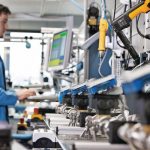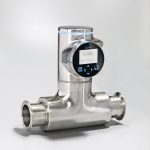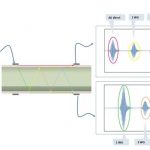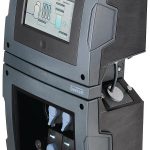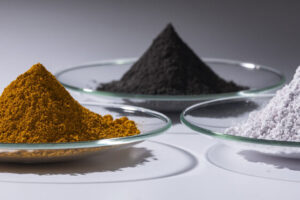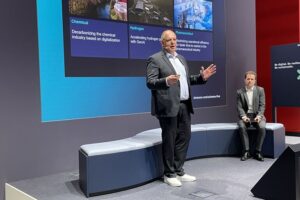Triembach-au-Val is a small, romantic village in the Vosges with around 450 inhabitants. As attractions Wikipedia lists the church of Saint-Christophe and the cemetery chapel. Further down the Wikipedia page there is a reference to a branch of Bürkert. The company’s Global Competence Centre for Industrial Sensors was the venue for a press conference in late June. The news communicated there to interested journalists is summarised in the following.
Author Dr. Bernd Rademacher Editor, cpp chemical plants and processes
Around 210 employees develop and produce sensors for the world market at the headquarters of Bürkert France in Triembach-au-Val (Alsace), one of five production sites within the group. The key competence of the Alsatian subsidiary is the development and production of industrial sensors for measuring pH, conductivity, level, pressure, temperature and flow.
To safeguard the company’s competitiveness, 8 % of the annual turnover generated in Triembach (currently around 32 million euros) is regularly invested in research and development. This continuous investment over a period of nearly 20 years has certainly proved worthwhile: the Alsatian factory is meanwhile established as the Group’s competence centre for sensors for industrial applications. Thirty-eight specialist engineers are committed to optimising the product portfolio and developing new, innovative products. The company’s R&D policy targets both new investments at the local level to promote new developments and support for external partners.
Experience, closeness and courage
With more than 60 years of experience, excellent customer relations, dedicated team players and the necessary courage to approach things from an unusual angle, Bürkert has made the transition from a supplier of components to a leading global enterprise for fluid control systems. “We are currently the only company in the world that can offer all the components in a fluid control loop from a single source”, explains CEO Heribert Rohrbeck. Bürkert combines optimally coordinated interfaces with sensors, valves and controllers to develop complete fluidic systems and automation solutions for its customers, providing them with measurable added value. Novel ideas and unorthodox strategies are firmly entrenched in the corporate tradition. “The Bürkert flow is the outcome of a precise blend of experience, closeness and courage in our projects. Perfect measurement and control of fluids and gases means satisfied customers and employees”, says Rohrbeck.
That this flow is the rule at Bürkert is impressively demonstrated by the company’s success. In 2013, for example, more than 2500 employees worldwide generated a group turnover of 411 million euros. All products are manufactured exclusively at five production sites in Germany and France.
Bürkert does not divide the target markets according to industries but rather based on the physical laws of the respective applications. This results in four market segments: Water, Gas, Hygienic und Micro. “When we develop new products and system solutions for these segments the focus is on creating measurable added value both for our customers and for our customers’ customers”, Rohrbeck emphasises. “Similar to the Internet, which derives its glob-al strength from interconnecting servers worldwide, we network the workforce and know-how of our 36 companies. We constantly question existing structures to bring forth new ideas”, he adds. This was also the case with the latest developments: Flowave, the type 8905 online analysis system and EDIP.
Flow measurement based on SAW
From the most basic paddle wheel system to an advanced Coriolis flow meter, each and every design has one or more operational constraints which must either be accepted and managed or rejected in favour of another, more suitable concept. Most mechanical flow meters, for example, have moving parts that require direct contact with the fluid flow; however, these can also restrict the flow and hinder hygienic cleaning processes.
The main principle behind this flow meter utilises propagation forms similar to seismic waves, which start from an initial point of excitation and spread across the surface of a solid material. Flowave features at least four interdigital transducers, which are located on the outside of the measuring tube and therefore have no direct contact with the liquid. Each transducer can act either as a transmitter or as a receiver.
Figure 2 shows one transducer emitting the wave, part of which travels directly to the first receiver. Another part of this same signal is transmitted through the liquid to the opposite end of the tube, where it is split again, with some of it going to the second receiver and the remainder travelling through the liquid, where the process is repeated. Thus, a single excitation causes a sequence of signals to be received by two other transducers.
The absolute time for the wave to travel from the transmitter to the receiver depends mainly on the tube diameter and the type of liquid. The difference between the propagation time in the forward and return directions is proportional to the flow. An analysis of all signals and comparisons based on different criteria such as amplitude, frequency and delay make it pos-sible to determine the quality of the measurement, the existence of gas bubbles or solids and the kind of liquid.
The flow meter has a simple, compact design and can be installed in any orientation without affecting performance. The basic type 8098 comprises an all-stainless steel body in four different sizes – DN 15, DN 25, DN 40 and DN 50 – which is fitted with a clamp connection to meet hygienic standards.
Online analysis systems
Designed as a compact, multi-channel, multi-function system, the type 8905 has the capacity to monitor up to five parameters within one enclosed unit while also providing connectivity options for USB, LAN and fieldbus. It is designed in two sections: the top half contains the electronic control part and includes a 7″ touch screen display as well as the comms modules, which can be used to further expand the unit or realise additional communication functions.
The bottom half of the unit contains the “sensor cubes”, which are plugged directly into the controller’s backplane, linking the sensors to the power supply, internal serial bus and fluidic connections. Each cube has the same dimensions and connections irrespective of its capabilities, and can be plugged in or removed from the unit while in operation (hot swapping).
Five sensor cubes are currently available to measure pH, oxidation reduction potential (ORP), conductivity, free chlorine and turbidity. The modular design of this system means the customer can start with a basic set of parameters that can be added to at any time without affecting the existing ones. When a new sensor cube is plugged into a free slot, it is registered with the system and its features are made available to all of the other mod-ules already installed.
Each sensor cube contains all the data neces-sary for the menus, configurations and specific functions – thanks to the use of Micro-Electro-Mechanical Systems or MEMS, a technology for miniaturising sensing systems. In other words, every cube is a self-contained analysis module that can be retrofitted to an existing system, so that a water treatment facility can expand its capabilities as required at minimal cost and in minimal time.
Both Flowave and the online analysis system already use the Efficient Device Integration Platform (EDIP), which includes a variety of functions, coordinated HMI devices and several other services to facilitate the integration of new devices.
cpp-net.com/0314403
Share:





